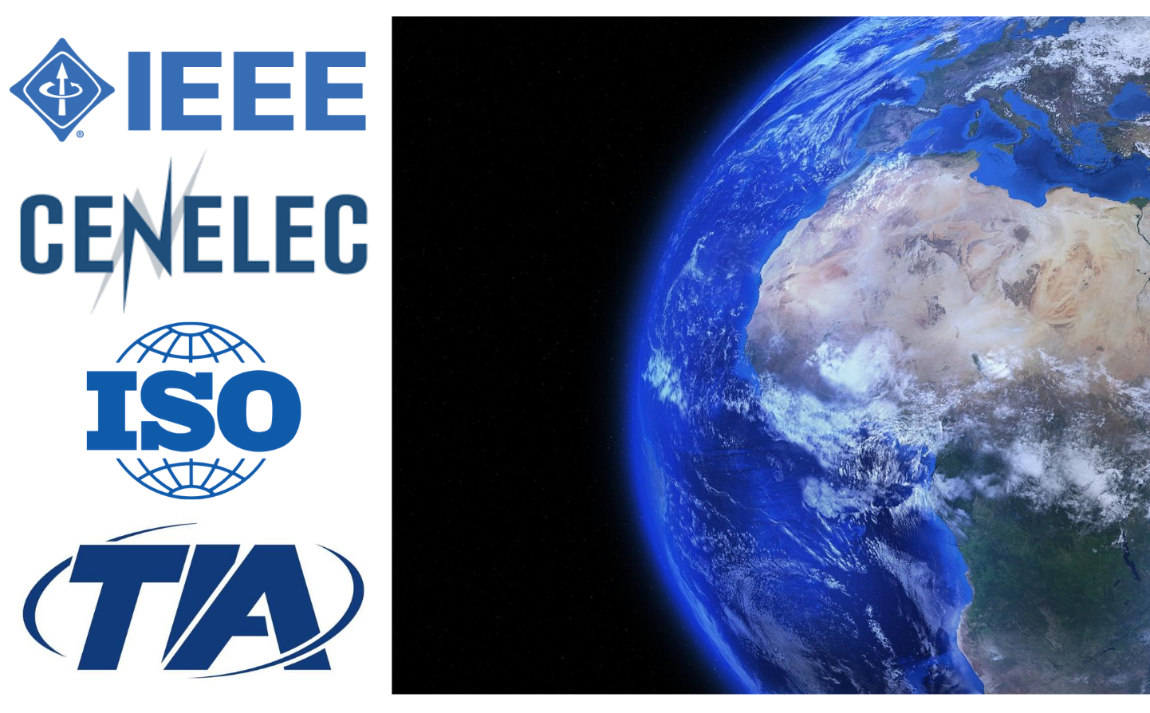OFFICE & ENTERPRISE
Structured Cabling Standards


Over 30 years ago, network cabling progressed from disparate proprietary systems to standardised universal structured cabling. This common network topology is based on twisted-pair copper and fibre optic cabling. The intention is to enable buildings to be pre-cabled in a way that would support any type of ICT system. In this post we will look at some of the main Standardisation bodies and the cabling standards they have published.
The importance of cabling Standards
To make this happen different Standardisation bodies were created. Each of these are made up of industry experts representing a range of parties from manufacturers and suppliers, users, consultants, training or educational establishments to others with a professional interest. The Standards they publish serve as a blueprint for the different manufacturers to follow when they develop products such as connectors, cables and patch cords. They also define standard procedures and methodology to be followed by those installing & testing these products, together with guidance on reporting and administration.
Standardisation organisations
Regional practices, language, customs and codes have resulted in the creation of different national and international Standardisation bodies. Installers will usually follow the Standards present in their country or region. The key players are:
International - International Organization for Standardization (ISO)
International - International Electrotechnical Commission (IEC)
International – Institute of Electrical and Electronics Engineers (IEEE)
Europe - European Committee for Electrotechnical Standardization (CENELEC)
US/Canada - Telecommunications Industry Association (TIA)
Most European countries follow the ISO and CENELEC Standards. Both Standard organisations work closely together, and their documentation, content and structure are very similar. Main difference is that ISO issues Standards from global country members whereas CENELEC’s Standards are established by input from EU countries.
IEEE standards are developed to enable the creation of network technology that is capable of interoperability between different vendors anywhere in the world.
The North American TIA Standard references a more limited set of cabling systems as opposed to the International and European Standards. Moreover, both ISO and CENELEC also define regional and country specific requirements.
Like ISO, the IEC is a global organisation that publishes International Standards for electrotechnology. ISO, CENELEC and TIA refer to IEC Standards when listing products and applications.
Given the fact that American based companies were involved in the development of network topologies, a lot of terminology we use today originates from these TIA Standards (T568B, Category, MER, UTP, FTP, STP). However, with the ongoing globalisation, more nomenclature is now based on the ISO Standards (Classes, U/UTP, F/UTP, S/FTP).
Structured Cabling Standards
The different Standards highlighted below each set a minimum performance level for cabling and components in order to maintain compliance. This goes from the design phase to installation methods and performance testing. In order to ensure any installed system performs at its best, even when the real-world conditions or environment may not be optimal, Nexans’ focus has always been to outperform these minimum requirements and create enough headroom so that the end user can be confident of reliable performance at all times.
A few of the key standards are listed below:
ISO and IEC created the Joint Technical Committee ISO/IEC JTC1/SC 25 to develop, among others, the International Standard ISO/IEC 11801 for telecommunications infrastructures in commercial buildings, data centres, industrial facilities and homes. This Standards scope covers generic cabling topologies, design, distance specifications and outlet configurations.
CENELEC’s European Standard series EN51073 defines the design requirements for both copper and fibre structured cabling installations in different installation areas. EN51073 is best suited for EU installers as CENELEC Standards are automatically adopted by each member state.
The original IEEE 802.3 Ethernet standard has been continually updated with additional specifications that are meant to improve and expand it to address additional use cases and environments. Care is taken to ensure that updates and improvements are backward compatible and maintain the integrity of the original system. IEEE addresses Enterprise wireless communication (Wi-Fi) in the 802.11 series of documents, which are also updated on a regular basis to improve the capabilities of these important networks.
TIA’s engineering committee TR-42 develops and maintains Standards for telecommunications cabling infrastructure in user-owned buildings primarily for North America. It’s TIA-568 Standards allows your cabling system to be interoperable with any networking or device application designed to work with that Standard.
